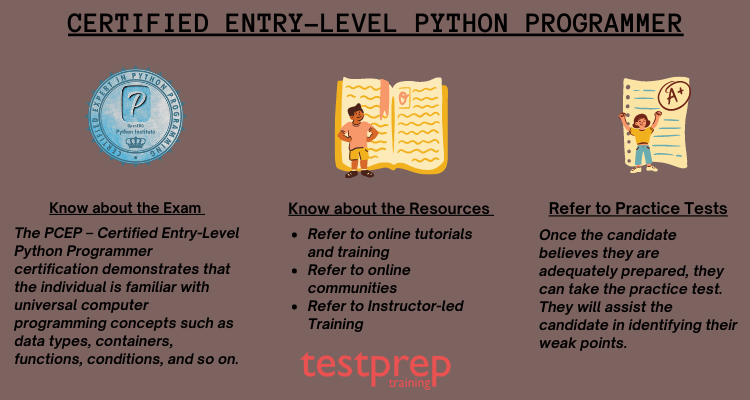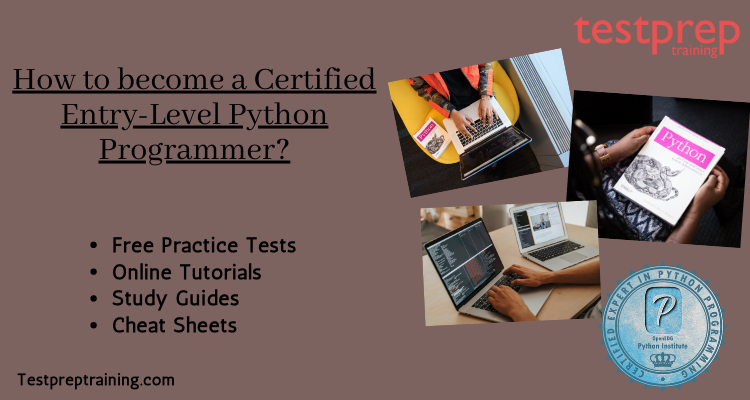Becoming a certified Python programmer can open up a world of opportunities, whether you’re looking to advance your career or pursue new projects and hobbies. The PCEP certification is an excellent starting point for those who are new to Python and want to demonstrate their proficiency in the language.
To become a certified entry-level Python programmer, you’ll need to have a solid understanding of the fundamentals of Python, including data types, control structures, functions, modules, and object-oriented programming. You’ll also need to be familiar with basic programming concepts such as algorithms and data structures, as well as have some experience with coding in Python.
Fortunately, there are many resources available to help you prepare for the PCEP exam, including online courses, textbooks, practice exams, and study guides. In this blog, we’ll provide you with practical tips and advice on how to navigate the certification process and succeed in passing the exam. Whether you’re a student, a professional, or someone interested in learning Python for personal growth, this blog will serve as a valuable resource to help you achieve your goals and become a certified entry-level Python programmer. So, let’s get started!
Becoming a Certified Entry-Level Python Programmer
To become a certified entry-level Python programmer, you can follow these steps:
- Learn Python: Start by learning Python programming language through online courses, books, or tutorials. There are various resources available online, like Codecademy, Coursera, edX, and many more. You can choose the one that suits you best.
- Practice Coding: Practice coding regularly to improve your skills. Solve problems and work on projects to gain practical experience.
- Get certified: The Python Institute offers the PCPP-32-1 exam, which is an entry-level certification for Python programmers. You can take this exam after you have learned Python and feel confident in your skills. You can find more information on the Python Institute website.
- Prepare for the exam: There are several resources available to prepare for the PCPP-32-1 exam, like study guides, sample questions, and practice exams. Make sure to review the exam objectives and study accordingly.
- Take the exam: Once you feel ready, register for the exam and take it at an approved testing center or online. The exam consists of multiple-choice and coding questions.
- Maintain certification: Once you have passed the exam, you will receive a certificate that is valid for three years. To maintain your certification, you will need to retake the exam or earn higher-level certifications.
- Join online communities: Joining online communities such as forums, Facebook groups, and Discord servers can help you connect with other learners and experienced programmers. You can ask questions, get feedback on your projects, and learn from others’ experiences.
- Build a portfolio: Create a portfolio of your projects to showcase your skills and knowledge to potential employers. This can include personal projects or contributions to open-source projects. It can also serve as a reference for your future work.
- Attend Python events: Attend local Python events, such as meetups or conferences, to network with other Python developers and learn about the latest trends and technologies in the field.
- Read the official Python documentation: The official Python documentation is a valuable resource for learning the language’s syntax and features. Make sure to familiarize yourself with it to gain a deeper understanding of the language.
- Practice problem-solving: Practice problem-solving by taking part in coding challenges or solving problems on websites such as HackerRank or LeetCode. This will help you improve your coding skills and prepare for the coding portion of the certification exam.
Becoming a certified entry-level Python programmer can open up many job opportunities, and it can also show your commitment to learning and developing your skills in the field of Python programming.
Tips and Tricks to become a Certified Entry-Level Python Programmer
Strategic planning requires an understanding of internal and external strengths and weaknesses, as well as threats and opportunities. Let us start making plans to become Entry-Level Python Programmer –

Step 1 – Know in-depth about the exam syllabus
The PCEP – Certified Entry-Level Python Programmer certification is a pre-requisite for the PCAP – Certified Associate in Python Programming certification and serves as a springboard for a career in software development, Python programming, and related technologies. Obtaining PCEP certification will help you stand out from the crowd and get your foot in the door. The following are the learning objectives for the Certified Entry-Level Python Programmer exam:
Basic Concepts (17%)
- fundamental concepts: interpreting and the interpreter, compilation and the compiler, language elements, lexis, syntax and semantics, Python keywords, instructions, indenting
- literals: Boolean, integer, floating-point numbers, scientific notation, strings
- comments
- the print() function
- the input() function
- numeral systems (binary, octal, decimal, hexadecimal)
- numeric operators: ** * / % // + –
- string operators: * +
- assignments and shortcut operators
Data Types, Evaluations, and Basic I/O Operations (20%)
- operators: unary and binary, priorities and binding
- bitwise operators: ~ & ^ | << >>
- Boolean operators: not and or
- Boolean expressions
- relational operators ( == != > >= < <= ), building complex Boolean expressions
- accuracy of floating-point numbers
- basic input and output operations using the input(), print(), int(), float(), str(), len() functions
- formatting print() output with end= and sep= arguments
- type casting
- basic calculations
- simple strings: constructing, assigning, indexing, immutability
Flow Control – loops and conditional blocks (20%)
- conditional statements: if, if-else, if-elif, if-elif-else
- multiple conditional statements
- the pass instruction
- building loops: while, for, range(), in
- iterating through sequences
- expanding loops: while-else, for-else
- nesting loops and conditional statements
- controlling loop execution: break, continue
Data Collections – Lists, Tuples, and Dictionaries (23%)
- simple lists: constructing vectors, indexing and slicing, the len() function
- Also, lists in detail: indexing, slicing, basic methods (append(), insert(), index()) and functions (len(), sorted(), etc.), del instruction, iterating lists with the for loop, initializing, in and not in operators, list comprehension, copying and cloning
- Furthermore, lists in lists: matrices and cubes
- Moreover, tuples: indexing, slicing, building, immutability
- Also, tuples vs. lists: similarities and differences, lists inside tuples and tuples inside lists
- Furthermore, dictionaries: building, indexing, adding and removing keys, iterating through dictionaries as well as their keys and values, checking key existence, keys(), items() and values() methods
- Moreover, strings in detail: escaping using the \ character, quotes and apostrophes inside strings, multiline strings, basic string functions.
Functions (20%)
- defining and invoking your own functions and generators
- return and yield keywords, returning results,
- the None keyword,
- Also, recursion
- Furtheemore, parameters vs. arguments,
- Moreover, positional keyword and mixed argument passing,
- default parameter values
- converting generator objects into lists using the list() function
- name scopes, name hiding (shadowing), the global keyword
Step 2 – Know about the Exam Format
Before embarking on your exam journey, you should have a basic understanding of the exam requirements. The PCEP-30-01 code denotes an entry-level exam for the Certified Entry-Level Python Programmer exam. Furthermore, the exam includes 30 multiple-choice and single-choice questions, as well as drag-and-drop and gap-fill questions. The candidate must obtain a score of 70% to pass the Certified Entry-Level Python Programmer exam. Furthermore, the candidate will have 45 minutes to complete the exam (exam) + approximately 5 minutes (Non-Disclosure Agreement/Tutorial), and the exam is only available in English. The examination costs USD 59.
Step 3 – Know about – What’s in the Future?
There are some important points to be aware of when taking this exam, including the scope and future of the exam. It is critical to understand whether the exam objectives align with your goals or the specific purpose you wish to achieve.
Naturally, Python has a wide range of applications. Python developers earn high salaries not only in India but also in countries such as the United Kingdom and the United States, where Python is the fastest-growing programming language. In India, the average salary of a Python developer with 2 to 4 years of experience is around 5 lakh, whereas that of a Ruby developer (compared to Ruby because it is touted as a potential competitor to Python) is 4.48 lakh.
Step 4 – Refer to the best Resources
The levels of knowledge and comprehension of various resources differ. However, in academic life, revision should be done on a case-by-case basis. As a result, matching the type of revision you do on your source material is critical. Here are some resources to help you with your planning:
Official training –
The candidate may also choose to participate in training programs offered by the Python Institute. The Python Institute offers a training program for each exam. All exam information, such as a description, intended audience, delivery method, duration, and so on, is included in the training programs for a specific exam. The candidate should enroll in a training program to become a Certified Entry-Level Python Programmer.
Study groups –
Participation in a group study or an online community will also help the candidate. It will encourage them to put in more effort. Furthermore, studying in a group will allow them to maintain contact with others who are on the same path as they are. Furthermore, such study groups’ discussions will aid students in their exams.
Online training –
For the conceptual portions, online training and instructor-led courses can be extremely beneficial. These classes are prepared by subject matter experts who are professionals in their fields. There are reliable websites that offer high-quality training sessions as well as notes that can be used as exam study material. Demo sessions can also help candidates decide which option is the best fit for them.
Practice tests –
Practice tests are given to candidates to reassure them about their preparation. Candidates will benefit from the practice test in identifying their weak points so that they can work on them. These days, there are numerous practice tests available on the internet, so the candidate can choose which one they prefer. Python Institute also offers its practice exam. The candidate can start studying for the Certified Entry-Level Python Programmer Exam right away!
Step 5 – Take the exam in accordance with the Expert’s Advice
Python is a very versatile language, and if you have a good understanding of it, you may be able to pursue a variety of career opportunities. Among these opportunities are the following: After learning Python, you can start working as a Python developer. Python developers are in charge of creating websites, optimizing data algorithms, and writing clean and efficient Python code. A data analyst must work with large amounts of data, analyze it, and visualize it. If you are a Python nerd who enjoys tinkering with data, this is the job for you.



